|
|
|
|
 | ||
|
Page 25 Sketching fashion? (summer, 2005) Here I am sitting by the old Nakagawa river on a hot and muggy day. That's the local train station behind me. It's actually built on a bridge that spans the Nakagawa. I got a new hat for sketching. It's the Australian Akubra Colly and it's a big one, and perfect for a day in the sun. I've owned several Akubras over the past 15 years (9 Akubras to be exact, plus a few Stetsons) and this one definitely looks the best on me (my wife even says so, and she is not crazy about any of my hats). I've got a big head (literally and probably figuratively) and it's no secret that a hat that looks good on a small head might not look so impressive on a big one because the brim looks smaller by comparison. I wish I bought this hat years ago. In my hand is my faithful yatate, and under me -- practically hidden from view -- is the portable stool made of three boards from page 22. It doesn't look like it would hold me, but I've been using it for two months, and so far it has held up under the strain. |
|
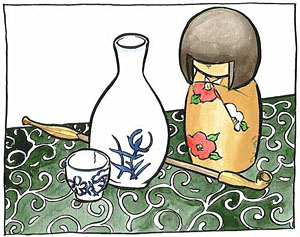
I have avoided still life sketches in my life because I always thought they were boring, but I'm discovering that I was wrong. This was fun. Now I know what I've been missing. For the outlines I used my yatate with bamboo brush and waterproof sumi (mokkan Boku) that I described on page 24. The sumi was absolutely water resistant when I added colors. The colors are "Shin Gansai" (new gansai) from Holbein. Gansai is the name for watercolors which use traditional Japanese pigments and binders. Holbein's new gansai apparently contains traditional Japanese pigments with modern watercolor binders. I used the colors straight without mixing for this sketch. Some gansai colors are more opaque than western watercolors. As usual, I used waterbrushes, starting where I wanted the colors to be darkest, and letting them lighten up naturally as I progressed. As you know, I have been experimenting with different materials and styles. Recently when I showed one of my sketches to my wife, she said that it wasn't my style, and looked like something she would have sketched. She's actually a good artist, so it wasn't a negative comment, but it did get me thinking because I didn't realize I had a style! When I asked her what my style was, she couldn't describe it, but she could recognize it when she saw it. | |
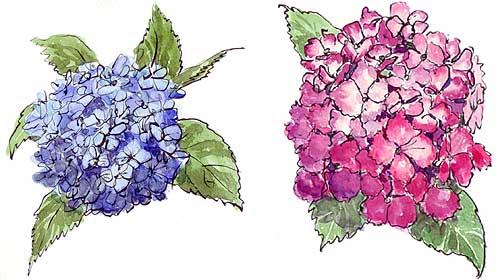 Here are a few sketches of ajisai (Hydrangeas in English) drawn at a local ajisai festival. They come out during rainy season and seem to lose their color in a few weeks. Maybe it gets washed out with the rain, I don't know. I don't usually sketch flowers, but I discovered they are gratifiying to sketch with their free forms and bright colors. I used a brush pen for drawing the outlines. I use the yatate when I have the freedom to do so, and brush pen when I'm pressed for time or cramped for space. I painted these with watercolors in my pocket watercolor box plus a waterbrush. I tried to utilize the gradually lightening characteristic of the waterbrush to get gradations. I wasn't sure if these sketches were in "my style" but I liked the results. |
|
|
In an attempt to discover "my style" which my wife had already recognized, I took out my sketchbooks from over the past few years and looked at all the sketches in one sitting. I discovered I was most drawn to sketches like the one below. 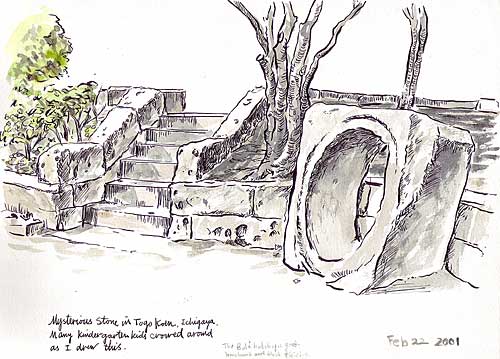 This was done four years ago in February, 2001, a few months before I began this online sketchbook. It was drawn at the former residence of Admiral Togo, now a park. That stone object was once the mouth of his well, now turned on its side so kids can play in it. This sketch had all the elements I really like: freely brushed ink outlines with a brush (brush pen) with hatching done with a stiff nib pen, and colored with watercolor. I seem to keep going back to this style. My wife confirms this is what she means by my style. Many of my sketches were done in this style, and a few have made it to this online sketchbook, but I don't think I ever singled this out as my own style until now. Now that I have found "my style" I will probably make a conscious effort to return to it more often after I've wandered from it (wandering is fun). Anyway, I decided to concentrate on this style for a while. I started to call it my "magic", and looked for subjects that would look good in this style. In other words, places where I could apply my magic. As I wandered about looking for a subject last week, the voice in my head was saying "Where can I apply the Stutler magic?" I know it sounds vain, but it was exactly the kind of "pep talk" I needed to hear. Try that kind of wording with your own style and see if it doesn't inspire you! I discovered if I looked at subjects in this light, I could almost imagine them already drawn, and the battle was already half won. Added later: It's funny to note that if you do a web search for "Stutler magic" you will find websites associated with the Disney Movie The Sorcerer's Apprentice which came out five years after I typed this. I thinks that's great, but I still use the phrase to remind myself to pursue this particular drawing style. |
|
|
After a long day of riding my bike around Tokyo searching for pens (I sell them on eBay) I was tired and stopped at the grounds of a Shinto shrine to rest. Maybe that sounds like a strange thing for a Christian to do, but they often have quiet parks around them with benches. And I do like the old architecture and cultural elements I find there. 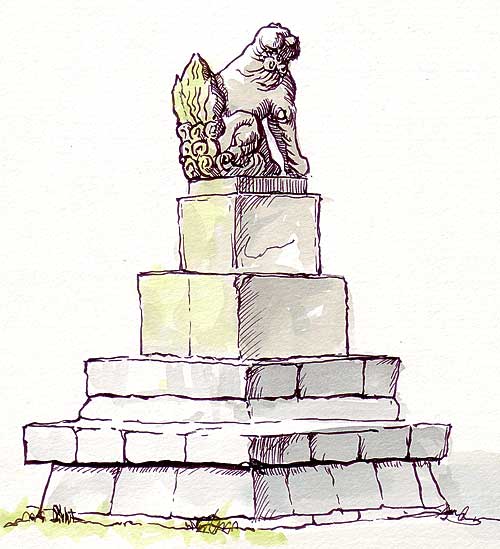 Directly in front of me was one of the "shishi" (Chinese lion) statues that guard the entrances to shrines and temples. I've drawn shishi statues before, I could imagine this one drawn in my style (a.k.a. the "magic") so I began to sketch it. It seemed like I was on the right track. |
|
 The next week I went back to one of my favorite sketch places, the Arakawa River and applied the "magic" to one of the boats. I used the brush and sumi from my yatate for outlines plus a stiff nib pen for hatching. It was late in the afternoon and I had no time to color it (I had intended to add the reflections with watercolor). 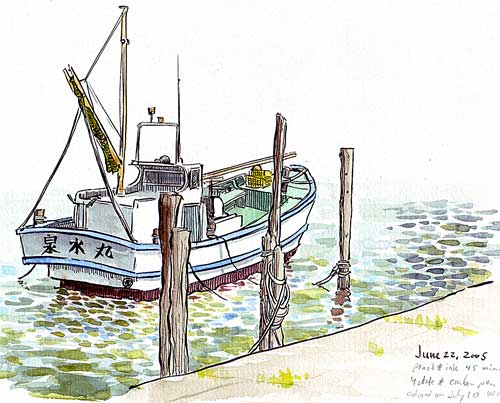 A few weeks later I did sit down and add color from memory and imagination without the benefit (or restraints) of the subject or even a photo of the subject in front of me. As much as I love to paint on location, I must admit there is something to be said for finishing the sketch away from the subject. You can put some of yourself into the drawing and paint from the heart rather than simply copy what's in front of you. I added the dark reflections on the right to balance the painting and also imply that there was something out there that was only represented by its reflection in the water. That leaves something for the imagination. A photograph would have had to include everything in the background including an ugly highway bridge. That's one advantage of drawing; just leave out the ugly and boring stuff. |
|
|
A few days later I found myself in Kameido at the end of my work day so I went to a nearby park to rest. Kameido means "turtle well" and here was a 7 foot tall fountain made of a sculpture of three winged turtles stacked on each other. Tenjin Shrine is nearby, and its ponds are filled with turtles, and I have observed many turtles resting just this way (except they don't have wings, and they don't stand on their hind legs). I could envision this fountain with the "magic" applied so I tried it. I believe the sketch took two hours, but this was so gratifying I lost all track of time! 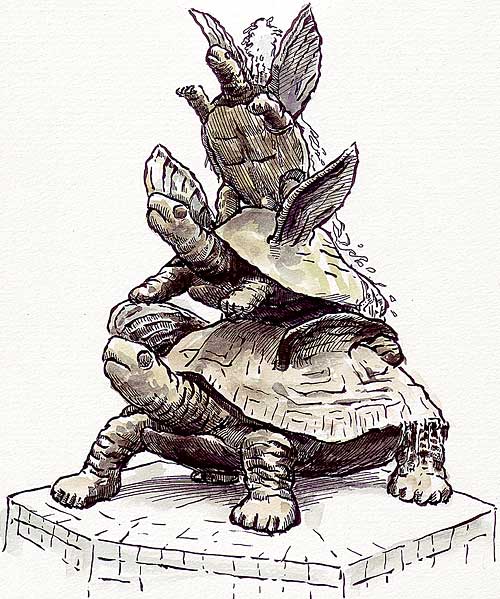 First I started with a rambling contour line pencil drawing, hardly lifting the pencil from the paper, and concentrating on relatonships between shapes rather than construction of objects (I hope that makes sense). Next I drew the outlines and details with my yatate brush and water proof sumi ink, telling myself the whole time to make lines that only a brush can make. Next I took my stiff nib Platinum Carbon ink pen and shaded in by hatching. I always use either this pen or a stiff nib Pilot MYU 701 for this work. I try to avoid cross hatching (going over the original hatched lines with more lines running in a different direction) because half the beauty of hatching is the white spaces between the lines. These are obliterated with cross hatching. I also avoid stippling (lots of little dots rather than lines) because I just don't like the effect. Then I erased the pencil lines with a soft plastic eraser and began coloring with Holbein Shin Gansai and a waterbrush. By the way, the idea of contour drawing without lifting the pencil has been very liberating for me. It makes for a quick and very accurate under-drawing. Before I discovered this, my under-drawings were often frustrating. I've seen this method taught in a few books, including the one by Bert Dodson called Keys to Drawing. It's in my recommended book list below. |
Next page >> |
 |